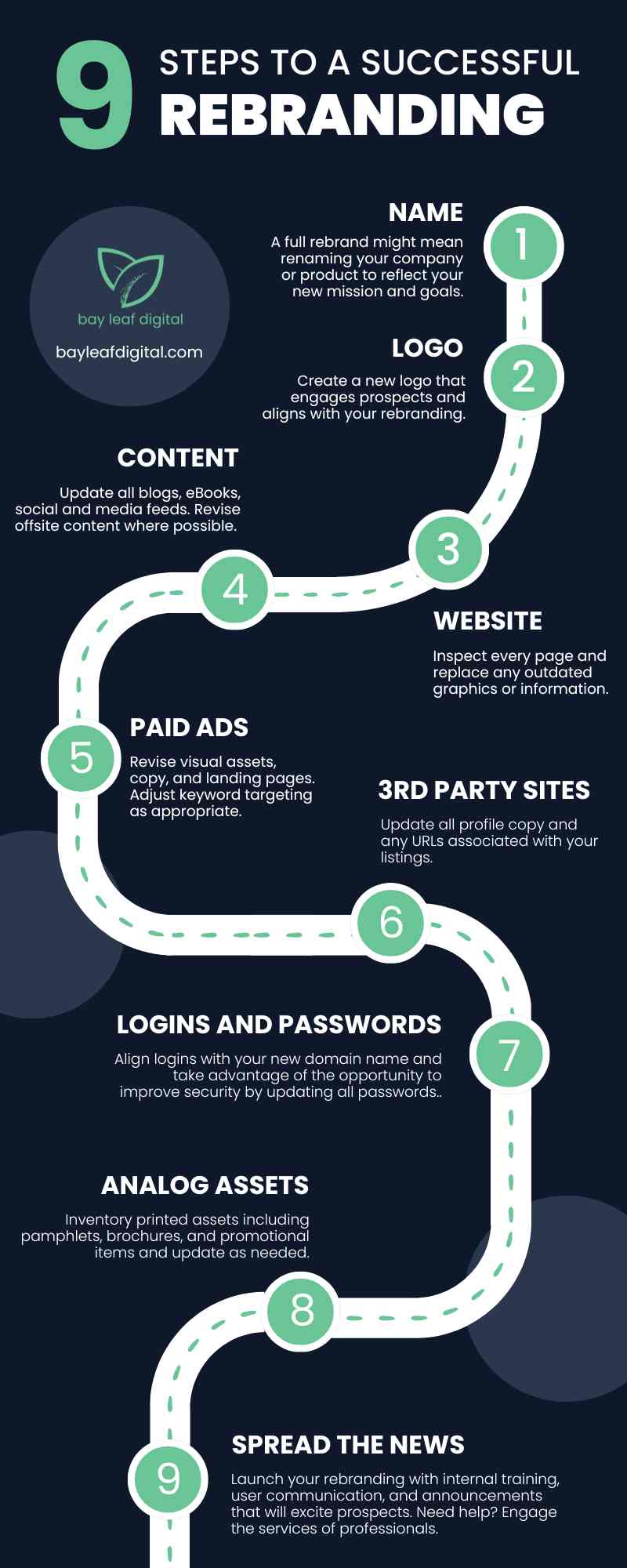Companies go through rebranding for many reasons. Maybe your product has expanded or changed significantly, it’s time for a market repositioning, or there’s been a merger or acquisition as part of a growth leap. Executed well, a rebranding can take companies to new levels of success. In 1996, when Federal Express became FedEx, the company undertook a monumental rebranding project. It was difficult (it’s not easy to give a fleet of airplanes a new paint job!) but the results were tremendous. As of early 2024, FedEx was valued at over $67B. In today’s digital age, the challenges around rebranding are even greater than they were 20 years ago. Now, rebranding a website is a more comprehensive undertaking that includes a host of digital identity checks and changes.
Successful rebranding requires a global vision and comprehensive execution. Anything less, and you risk a calamity.
So, when a rebranding is appropriate, how should you go about managing your digital assets? Start with a rebranding checklist and return to it often. You’ll need to accomplish every item on it.

The Bay Leaf Digital team has steered many clients through rebranding a website and more, and we have first-hand perspective into the digital marketing strategy and implementation steps required. Let’s look at them together.
New Name, New Look
Rebranding often begins with a pivotal element: your company’s name. If your name no longer reflects your mission, vision, and product, it’s time for a new one. A new name is a powerful signal to customers, partners, and competitors that significant changes are underway. Fresh graphic design brings this transformation to life. This will involve a new logo, along with updated fonts and colors, all working together to convey your brand’s identity, personality, and values.
Rebranding a Website
With these items in place, it’s time to refresh your online presence. Rebranding a website extends deep into its structure and user experience. Acting as your digital front door, your website must consistently reflect the new brand identity across every page. This means you’ll have to reevaluate the site’s layout, navigation, and content. Key considerations include:
- Have you secured any domain names necessary for your rebranding?
- Is the rebuilt website accessible and mobile-friendly?
- Do the new color scheme and typography improve readability?
- Is the redesigned logo positioned prominently and consistently for instant recognition on every page?
Take advantage of this opportunity to optimize your website for search engines so that customers can easily find you, especially if a new name is involved.
Revise Content
When you’re rebranding a website, revisions should focus on aligning all content with the company’s new mission, vision, and values. Ensure that content tone and messaging accurately reflect your updated brand guide. Maintain visual consistency across the site by updating visual elements including images, illustrations, logo, fonts, colors, and other design features on all content pages.
Revise any off-site content as well. Inventory and update guest posts, videos, and thought leadership pieces placed at external websites, podcasts, and other media outlets. As much as possible, modify author information and images to incorporate the new brand elements and voice.
Adjust Active Paid Advertising Campaigns
Audit your active paid advertising campaigns and adjust as needed to ensure that your advertising efforts remain effective and consistent with your new brand identity.
- Update all visual assets including banners, display ads, and video content to reflect your new look. This includes banners, display ads, and video content.
- Revise text to align with your new messaging and tone. Ensure that any references to your company name, products, or services are updated.
- Rework landing pages as needed. Consistency between your ads and SaaS landing pages improves the user experience and conversion rates.
- Update your keyword strategies and targeting options to align with any changes in your brand’s focus or target audience.
- Monitor campaign performance after implementing these changes. Pay attention to metrics like click-through rate (CTR), conversion rate, and return on ad spend (ROAS) to gauge the impact of your updates.
- Iterate based on the insights gathered from performance data to make further adjustments. Testing different variations of your ads can help identify what resonates best with your audience.
Update Listings on Business Directories and Review Sites
When rebranding a website, you’ll also want to update any directory listings and make sure they contain newly identified keywords, messaging, logos and imagery. An up-to-date spreadsheet documenting all SaaS directory listings and review sites on which you maintain a presence is an invaluable tool. If you don’t have one already, now is the time to create it. Your records should include:
- All directories (Google Business, Bing, etc.) and review sites (Capterra, GetApp, Software Advice, G2, etc.) where you maintain a listing.
- Secure location of access credentials.
- Directory or review site profile copy.
- Any assets, email addresses, or links associated with listings.
Change Logins for Tools
If your domain name has changed, your login credentials probably will, too. Store the new login information in a secure place. Change passwords regularly, especially after staff turnover.
Refresh Printed Marketing Materials and Merchandise
Remember your analog assets while rebranding a website. Revise brochures, business cards, flyers, contracts, and other printed collateral to incorporate the new logo, color scheme, and brand messaging. If you keep a supply of t-shirts, water bottles, and other promotional products on hand, get those updated, too. Start with an inventory of existing materials to determine what needs updating, redesigning, or reprinting. Collaborate with designers to align the look and feel of these materials with the new brand standards and ensure consistency across all visual and textual elements. Finally, coordinate with printing services to produce high-quality, rebranded materials.
Communicate the Change
Effectively sharing the news of your rebranding will require you to craft tailored messages for each stakeholder group and ensure the message is received and understood by all by using various methods of communication. In all cases, the message should be clear and consistent: the rebrand represents a strategic move toward improved services, offerings, and alignment with the company’s mission and values.
- Staff: Internal communication should focus on the reasons behind the rebranding, the benefits it brings, and how it will affect their roles. Use internal newsletters, company-wide meetings, and training sessions to educate staff about the new brand messaging, visual identity, and how to communicate these changes externally. Training should also include practical exercises on using the new brand assets and guidelines to ensure consistent application across all company activities.
- Clients: Update all staff signature files, then send personalized client emails explaining the reasons for the rebranding, the direct benefits to them, and any changes in processes or contact information they might expect can be very effective. Follow-up calls or meetings with account managers will provide a personal touch, allowing clients to ask questions and get reassured about the continuity of service and the value the rebranding brings to their business relationship.
- Prospects: Leverage social media, press releases, and updated marketing materials to broadcast the rebrand, focusing on the benefits and improved offerings. Highlight the evolution of the company, emphasizing how the rebrand aligns with prospects’ needs and enhances the solutions offered. Webinars or open-house events can serve as interactive platforms for prospects to experience the rebranded company firsthand, encouraging engagement and inquiries.
Lead the Way to a Successful Rebranding
Rebranding a website and overhauling everything that goes with it is a complete transformation that will touch every aspect of your SaaS. Successfully navigating the change requires careful planning, clear communication, and strategic execution across all channels and with all stakeholders. From refreshing marketing materials and adjusting paid advertising campaigns to updating business directory listings and communicating effectively with staff, clients, and prospects, each step is crucial for maintaining consistency and reinforcing the new brand identity. By focusing on the reasons behind the rebranding and the benefits it brings, you will ensure a seamless transition and position your company for long-term success and growth.
Is your SaaS ready to embark on a rebranding, or do you need help marketing your new identity? The expert SaaS marketing specialists at Bay Leaf Digital are here to help. Contact us and let’s start a conversation today.



